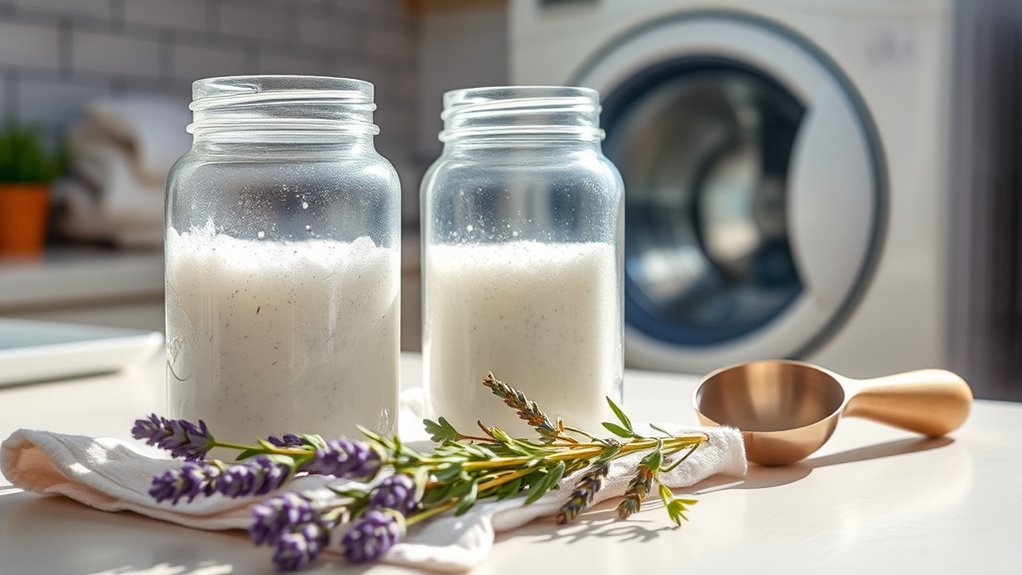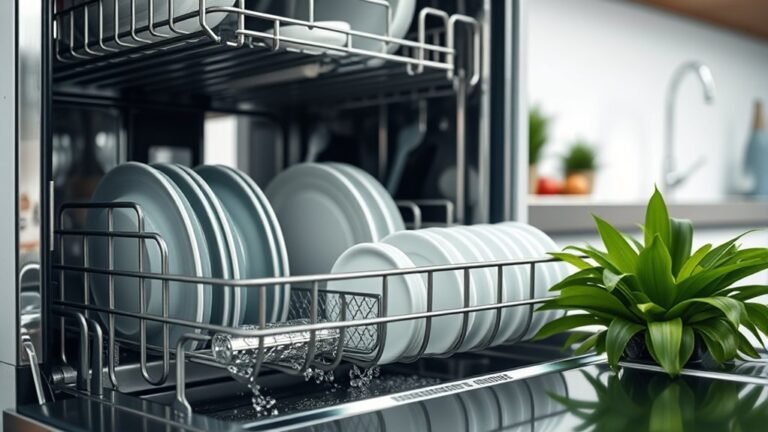DIY Cleaner for Laundry
You can make an effective DIY laundry cleaner using washing soda, borax, and grated castile soap, mixed evenly for a balanced base. Use about two tablespoons per load, adjusting for soil level. To boost cleaning, add baking soda or white vinegar during the cycle. Essential oils like lavender add a natural scent safely. Store your detergent airtight, away from light. For deeper insight into natural stain removers and optimized methods, keep exploring these approaches.
Benefits of Using Homemade Laundry Cleaners
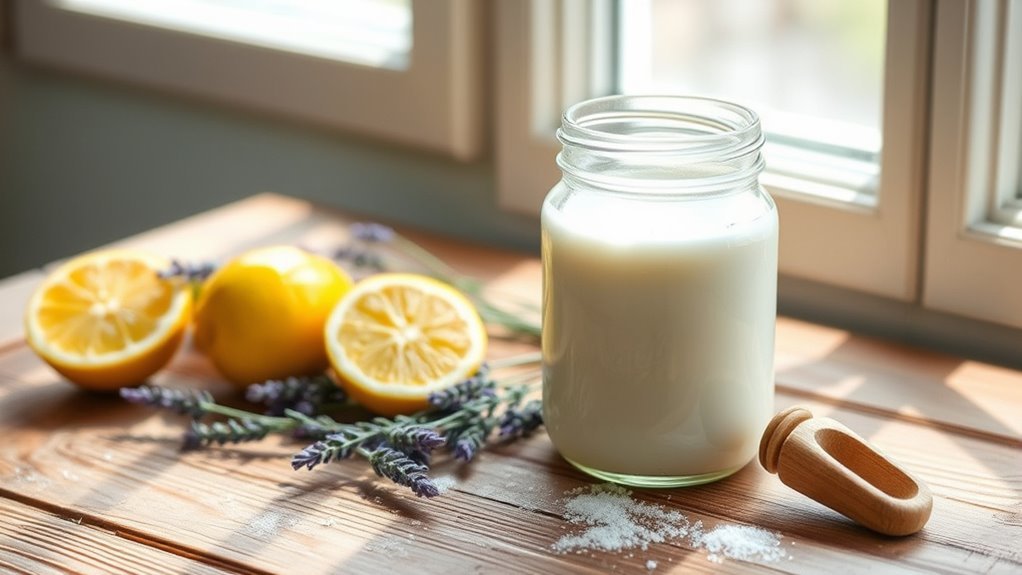
Although commercial laundry detergents are widely available, using homemade laundry cleaners offers several distinct advantages that can enhance both your washing process and overall household efficiency. By choosing eco friendly alternatives, you reduce exposure to harsh chemicals, minimizing environmental impact and promoting sustainable living. These DIY solutions allow for precise control over ingredients, ensuring compatibility with sensitive skin and fabric types. Additionally, crafting your own detergent leads to significant cost savings, as bulk, natural components are often less expensive than commercial products. This methodical approach not only frees you from reliance on mass-produced items but also empowers you to optimize cleaning performance tailored to your needs. Embracing homemade cleaners is a strategic decision that balances environmental responsibility with economic practicality, granting you greater autonomy in household maintenance.
Essential Ingredients for DIY Laundry Detergents
To create an effective DIY laundry detergent, you’ll need to start with common base ingredients like washing soda and castile soap. Natural boosters such as baking soda or oxygen bleach enhance cleaning power without harsh chemicals. Finally, you can customize your detergent with scenting options like essential oils to achieve a fresh, pleasant aroma.
Common Base Ingredients
When creating your own laundry detergent, you’ll need a few key base ingredients that form the foundation of effective cleaning. Start with a natural alternative to traditional synthetic surfactants, such as castile soap or soap flakes, which provide cleansing power without harsh chemicals. Next, incorporate washing soda (sodium carbonate) to soften water and enhance stain removal. Borax is another common base ingredient, acting as a natural disinfectant and deodorizer. These eco friendly options reduce environmental impact while maintaining cleaning efficiency. You can also add baking soda to regulate pH and boost odor control. By selecting these common base ingredients, you maintain control over your detergent’s composition, ensuring it’s both effective and aligned with your values for sustainability and freedom from commercial additives.
Natural Boosters
Building on the base ingredients that form the core of your detergent, natural boosters enhance cleaning performance and target specific laundry challenges. You can incorporate natural enzyme boosters to break down proteins, starches, and fats effectively, improving stain removal without harsh chemicals. These enzymes operate efficiently within specific pH ranges, so maintaining detergent balance is essential. Additionally, citrus extracts serve as powerful natural degreasers and brighteners, leveraging their limonene content to dissolve oily residues. They also contribute mild antimicrobial properties, supporting fabric freshness. When formulating your DIY cleaner, measure boosters precisely to avoid compromising fabric integrity or washing machine functionality. Integrating these natural enzyme boosters and citrus extracts empowers you with a customizable, efficient laundry solution that respects both your freedom and environmental responsibility.
Scenting Options
Although scent may seem secondary to cleaning power, selecting the right fragrance components is essential for crafting effective DIY laundry detergents. You’ll want to choose scented oils that are both skin-safe and compatible with your detergent base. Essential oils like lavender, eucalyptus, and lemon provide natural antimicrobial properties while imparting fresh aromas. When applying scented oils, dilute them properly to avoid fabric staining or skin irritation. If you prefer fragrance alternatives, consider botanical extracts or fragrance-free options to maintain hypoallergenic qualities. Keep in mind that scented oils vary in volatility; some dissipate quickly, so combining oils with fixatives like jojoba oil can extend scent longevity. By methodically balancing scented oils and fragrance alternatives, you gain control over your detergent’s aroma without compromising cleaning efficiency or personal freedom.
How to Make a Basic Powdered Laundry Detergent
Three simple ingredients form the foundation of a basic powdered laundry detergent you can make at home. You’ll need washing soda, borax, and grated bar soap. Start by measuring 1 cup of washing soda, 1 cup of borax, and 1 cup of finely grated soap. Combine these thoroughly in a large container to guarantee even distribution. This mixture serves as an effective alternative laundry solution, offering eco friendly options that reduce chemical exposure and plastic waste. Use about 2 tablespoons per regular load, adjusting as needed for heavily soiled clothes. This method gives you control over ingredients, promoting freedom from commercial additives. Store the detergent in a sealed container to maintain potency. This straightforward recipe balances efficiency with environmental responsibility.
Liquid Laundry Soap Recipe for Sensitive Skin
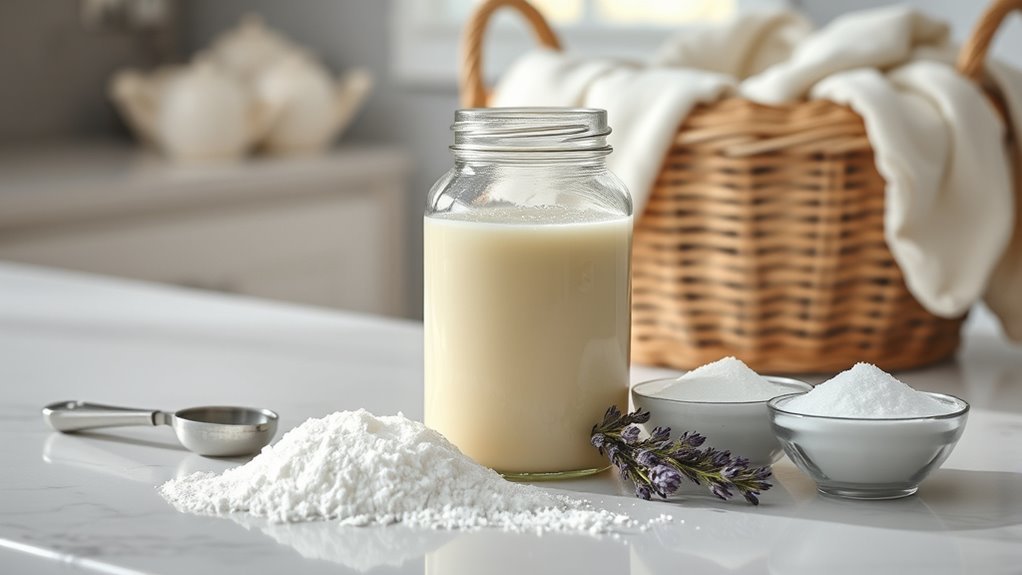
You’ll use mild, hypoallergenic ingredients to formulate this liquid laundry soap, ensuring it’s safe for sensitive skin. Follow a precise sequence of mixing and heating steps to prepare the solution effectively. Finally, store the soap properly to maintain its stability and optimize cleaning performance.
Gentle Ingredients Overview
When crafting a liquid laundry soap for sensitive skin, selecting gentle ingredients is crucial to minimize irritation while maintaining cleaning efficacy. You’ll want to prioritize eco friendly options such as castile soap, which provides a biodegradable, plant-based surfactant that effectively removes dirt without harsh chemicals. Incorporating allergy friendly choices like baking soda helps regulate pH and soften fabrics without triggering sensitivities. Avoid synthetic fragrances and dyes; instead, opt for natural essential oils in minimal amounts for a subtle scent. Additionally, using distilled water guarantees purity, preventing contaminants that could irritate skin. This methodical selection process assures a balanced formula that cleans thoroughly yet respects your skin’s delicate nature, granting you freedom from irritation while securing your laundry is fresh and safe.
Step-by-Step Preparation
To prepare your liquid laundry soap for sensitive skin, start by gathering all necessary ingredients and equipment to guarantee a smooth process. This step guarantees you use eco friendly alternatives while achieving cost effective solutions. You’ll need:
- A large pot for boiling water
- Grated castile soap or gentle soap flakes
- A mixing container with a lid for storage
Begin by boiling 4 cups of water. Slowly add 1 cup of grated castile soap, stirring until fully dissolved. Pour this mixture into your container, then add 1 gallon of hot water and 1/2 cup of washing soda. Stir thoroughly to combine all ingredients. Allow the soap to cool and thicken before sealing the container. This methodical approach aids in maintaining skin safety and environmental responsibility without overspending.
Usage and Storage Tips
Once your liquid laundry soap has cooled and thickened, proper usage and storage become key to maintaining its effectiveness and longevity. You should use the soap consistently but avoid overuse; a typical usage frequency is 1-2 tablespoons per load. Storing your soap in airtight, opaque storage containers will prevent contamination and degradation from light exposure.
| Aspect | Recommendation |
|---|---|
| Usage Frequency | 1-2 tablespoons per load |
| Storage Containers | Airtight, opaque plastic/jar |
| Temperature | Store at room temperature |
Keep storage containers tightly sealed and away from extreme temperatures. This methodical approach guarantees your DIY soap remains potent and safe, giving you the freedom to enjoy clean laundry without harsh chemicals.
Natural Stain Removers You Can Make at Home
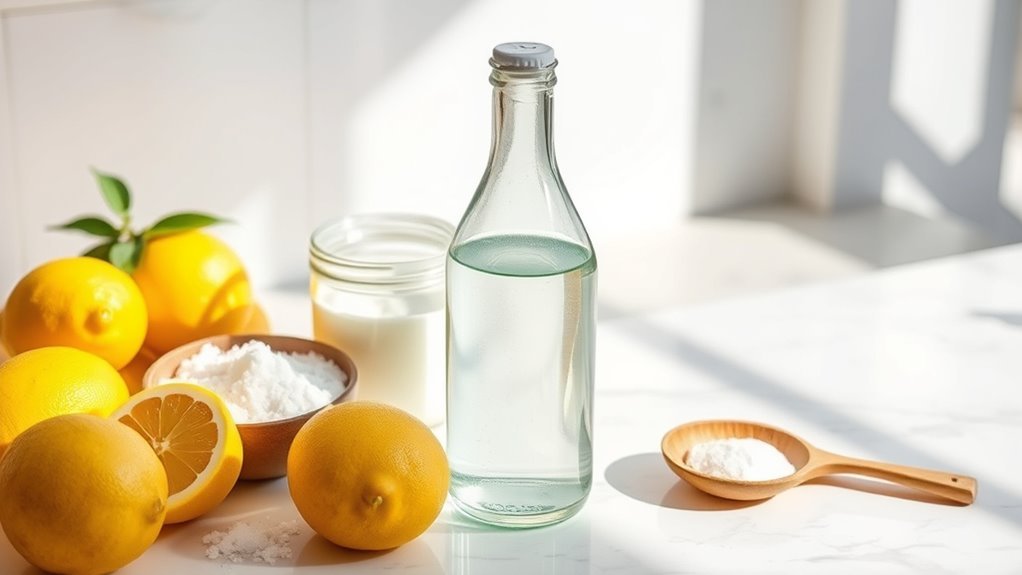
Although commercial stain removers are widely available, you can create effective natural alternatives using common household ingredients. These homemade remedies offer eco friendly alternatives that reduce chemical exposure and environmental impact. By understanding the chemistry behind each ingredient, you gain the freedom to treat stains precisely and safely. Consider these three natural stain removers:
- Baking Soda Paste: Mix baking soda with water to form a paste. Apply to stains, let sit for 30 minutes, then rinse. It neutralizes acidity and lifts dirt.
- White Vinegar Solution: Dilute vinegar with water (1:1 ratio). Spray on stains, wait 15 minutes, then wash. It breaks down grease and deodorizes.
- Lemon Juice: Apply lemon juice directly to stains and expose to sunlight briefly. The natural bleaching effect lightens discolorations effectively.
These methods empower you to tackle stains responsibly and efficiently.
Adding Essential Oils for a Fresh Laundry Scent
After treating stains with natural solutions, you might want to enhance your laundry with a pleasant scent that’s both safe and effective. To do this, select essential oil types known for their antimicrobial and aromatic properties, such as lavender, eucalyptus, or tea tree. Combine these oils in balanced scent combinations to customize your laundry fragrance. For example, mixing citrus oils like lemon with floral notes like geranium creates a fresh, uplifting aroma. Add 10-15 drops of your chosen blend per batch of detergent or rinse cycle. Confirm oils are thoroughly mixed to avoid uneven scent distribution. This method preserves your freedom to tailor laundry scents while maintaining safety and natural efficacy, replacing synthetic fragrances with customizable, eco-friendly alternatives.
Tips for Using Homemade Detergents Effectively
When you switch to homemade detergents, understanding their unique properties is essential to achieve ideal cleaning results. Homemade detergent effectiveness depends on proper dosage, water temperature, and fabric type. To optimize laundry performance, consider these tips:
- Use precise measurements to avoid residue or insufficient cleaning power.
- Adjust water temperature to enhance ingredient activation without damaging fabrics.
- Pre-treat stains promptly to compensate for the milder action of homemade formulas.
How to Boost Cleaning Power With Common Household Items
Since homemade detergents may lack some commercial-strength cleaning agents, you can enhance their effectiveness by incorporating common household items. Using these eco-friendly alternatives aligns with your desire for freedom from harsh chemicals. Applying precise laundry tips guarantees you get ideal results.
| Household Item | Purpose |
|---|---|
| Baking Soda | Boosts detergent’s cleaning power and deodorizes |
| White Vinegar | Softens fabrics and removes residues |
| Hydrogen Peroxide | Brightens whites and disinfects |
| Lemon Juice | Acts as a natural bleach and stain remover |
Add these boosters in measured amounts during your wash cycle to enhance stain removal and freshness without compromising fabric integrity. This methodical approach maximizes your DIY cleaner’s efficiency, guaranteeing clean, fresh laundry while maintaining eco-conscious practices.
Safe Storage and Shelf Life of DIY Laundry Cleaners
Although DIY laundry cleaners are composed of simple, natural ingredients, proper storage is essential to maintain their effectiveness and prevent contamination. To guarantee ideal shelf stability, select airtight, non-reactive storage containers such as glass or BPA-free plastic. Store your cleaner in a cool, dry place away from direct sunlight to avoid degradation of active components. Label your containers with preparation dates to monitor freshness accurately.
Properly store DIY laundry cleaners in airtight, non-reactive containers away from sunlight to preserve effectiveness and freshness.
Keep these key points in mind:
- Use opaque or dark-colored storage containers to minimize light exposure.
- Avoid metal containers that may react chemically with ingredients.
- Maintain consistent temperature and humidity levels to preserve formula integrity.
Troubleshooting Common Issues With Homemade Detergents
If you notice detergent residue on your clothes, it’s likely due to improper dilution or water hardness. To maintain fabric softness, you’ll need to balance your recipe’s ingredients and consider adding natural softeners. Preventing color fading requires controlling wash temperature and avoiding harsh additives.
Detergent Residue Problems
When you notice a film or buildup on your clothes after washing with homemade detergent, it usually indicates detergent residue problems. This residue can cause detergent buildup that not only dulls fabrics but also accelerates fabric wear over time. To troubleshoot effectively, consider these steps:
- Adjust detergent concentration: Using too much homemade detergent leads to excess residue.
- Optimize water temperature: Warm or hot water helps dissolve ingredients better, reducing buildup.
- Improve rinsing cycles: Additional rinse cycles flush out residual detergent thoroughly.
Maintaining Fabric Softness
Detergent residue not only affects fabric appearance but can also impact softness, making it harder to maintain the desired texture of your laundry. To guarantee ideal fabric care, thoroughly rinse your garments to remove any leftover detergent molecules that can stiffen fibers. Incorporate softness tips such as adding a small amount of white vinegar during the rinse cycle; it acts as a natural fabric softener without leaving residues. Avoid overusing homemade detergent, as excessive amounts contribute to buildup and reduce softness. When washing, choose gentle cycles to prevent fiber damage and maintain fabric integrity. Regularly clean your washing machine to prevent residue accumulation that transfers onto clothes. These methodical steps help you sustain fabric softness while embracing the freedom of DIY laundry solutions.
Preventing Color Fading
Although homemade cleaners offer many benefits, they can sometimes contribute to color fading if not properly formulated or used. To guarantee effective color preservation techniques while maintaining fabric care, you need to control detergent pH and avoid harsh ingredients that strip dyes. Opt for mild surfactants and include natural color boosters like vinegar. Additionally, adjust washing parameters to minimize mechanical stress on fibers.
To prevent color fading in your DIY laundry routine, consider:
- Using cold water washes to reduce dye loss
- Adding natural antioxidants such as vitamin E or green tea extracts
- Limiting exposure to direct sunlight when drying fabrics
Frequently Asked Questions
Can DIY Laundry Cleaners Be Used in All Washing Machines?
You’ll want to verify if your washing machine is among the compatible machines before using any cleaner. Not all formulas suit every type, especially high-efficiency models that require low-sudsing agents. Using an incompatible cleaner can reduce cleaning effectiveness or even damage your machine. Always check manufacturer guidelines and test a small load first. This way, you maintain freedom in your cleaning choices without compromising your washer’s performance.
Are Homemade Detergents Safe for Baby Clothes?
Worried about baby skin sensitivity when washing their clothes? You should know that homemade detergents made with natural ingredients can be safe if formulated carefully. Avoid harsh chemicals, fragrances, and dyes to reduce irritation risks. It’s crucial to test your mixture on a small fabric patch and rinse thoroughly to prevent residue buildup. With the right method, your baby’s clothes will stay clean and gentle, giving you freedom from commercial additives.
How Do DIY Cleaners Affect Fabric Colors Over Time?
You’ll find that DIY cleaners can impact color fading depending on their ingredients. Harsh substances like bleach alternatives or strong alkalis may accelerate fading, reducing fabric longevity. However, milder agents such as gentle soaps or baking soda tend to preserve colors better. To maintain fabric longevity and minimize color fading, you should carefully balance your formulation’s pH and avoid abrasive additives, giving you freedom to clean effectively without compromising your clothes’ vibrancy.
Can I Use DIY Laundry Detergent for Hand Washing Clothes?
You can definitely use DIY laundry detergent for hand washing clothes, but you’ll want to verify its detergent effectiveness matches your needs. Hand washing demands a gentle yet efficient formula to break down soils without harsh agitation. Since you control the ingredients, you can adjust surfactant levels for ideal cleaning while preserving fabric integrity. This method gives you freedom to customize your detergent, balancing cleaning power with fabric care during hand washing.
What Are the Environmental Impacts of Homemade Laundry Cleaners?
Imagine a river clear of chemical runoff—your homemade cleaner can help accomplish this. By choosing sustainable ingredients like plant-based soaps and baking soda, you reduce harmful pollutants entering waterways. Plus, using reusable containers minimizes packaging waste, cutting down plastic pollution. Your methodical choice of eco-friendly components guarantees less environmental strain, granting you the freedom to clean effectively while preserving the planet for future generations.
